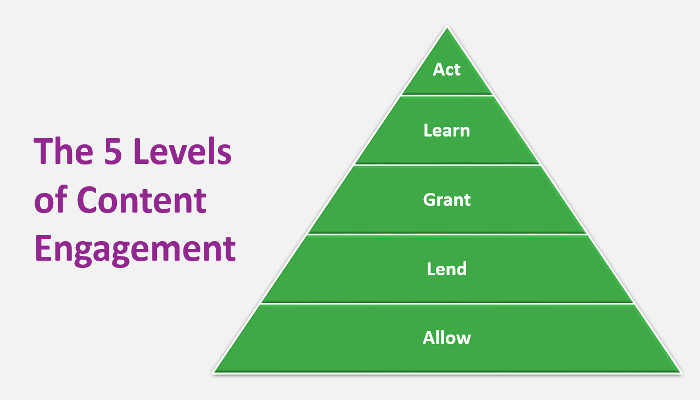According to the 2016 B2B Content Benchmark Report, the top challenge for marketers is “creating engaging content.”
“B2B marketers, as in years past, continue to be heavily focused on creating engaging content (72%), citing it as the top priority for their internal content creators over the next year.”
And while almost three-quarters of the respondents have the same challenge, few will likely agree on a definition for the term. Just ask ten marketers for their definition of engagement to see what I mean. So, without a common definition to work from, it wouldn’t surprise me if “creating engaging content” tops the list for 2017, 2018, and 2019.
The definition for engagement should be simple. At its essence, engagement means that the audience does something. They take action. But that’s where a specific definition gets tricky because the types of activities extend far and wide.
For example, an audience may read beyond a headline (action #1), complete reading the content (action 2), comprehend the message (action 3), until finally making some sort of physical action, such as clicking on a link (action 4), speaking to a sales rep (action 5), or placing an order (action 6). No wonder why marketers are having a hard time wrapping their heads around the concept. Engagement appears to be a moving target.
So, what if we suggest a model to help content creators navigate through the various types of engagements?
Each audience action can be put into one of five serial categories:
- I drop my defenses and allow your content into my world
- I agree to loan you more of my attention
- I grant you the right to present your proposal
- I learn something valuable and meaningful
- I’m inspired to act

Engagement #1: I drop my defenses and allow your content into my world
Smartphones have placed us into a state of perpetual stimulation. We’re constantly reacting to notifications of text messages, Facebook updates, emails, and calendar reminders. Web pages and apps hit us with advertisements, trending topics, breaking news, and viral cat videos. And as a result, we’ve become leery.
We view titillating headlines with cynicism, solicited offers with skepticism, and unsolicited offers as scams. We employ an array of digital defense technologies to filter spam, block pop-ups and fast forward through little blue pill commercials with DVRs.
Content marketers must differentiate themselves from the noise. They must know who we are and have something unique to say. If successful, we’ll drop our defenses momentarily and allow them in.
Engagement #2: I agree to loan you more of my attention
Just because we’ve allowed the content through our defenses, we haven’t guaranteed any future engagement. Content marketers have earned a ten-second audition. Do a good job and the audition is extended for a couple more minutes. Do a bad job and we fling them back with the untrusted masses.
Content creators earn longer auditions within the first couple of sentences. Stimulate our interests. Offer us something relevant. Give us someone to root for or a reason to care.
Engagement #3: I grant you the right to offer your proposal
If the content can get past those critical early moments, we’re likely to reward it by offering a more focussed part our attention. It’s showtime. Give us a new way of looking at an old situation, reveal information that has special meaning to us. Make us question an assumption. Lead us to an Aha! moment.
Engagement #4: I learn something valuable and meaningful
The fourth level of engagement is where traditional marketers should feel comfortable. Our attention has been earned and we’re ready to hear some of the narrative facts. Give us some feeds, speeds, and benefits. Teach us the implications of action or inaction. Help us understand both the upside and the downside of the offering.
Engagement #5: I’m inspired to act
Finally, the moment of truth. Hopefully, the content has inspired us to put this new knowledge into action. Perhaps we’ll change a behavior. Or perhaps we’ll respond to a call-to-action and click, download, inquire, or ultimately purchase.
Measuring Engagement
In addition to creating engaging content, marketers are asked to measure it. So how do they measure the five levels of content engagement?
The five levels are divided into two categories: hard engagement and soft engagement. Hard engagement, like Engagement #5, is measurable. Clicks, downloads, web hits, leads, and sales can be tied directly to content engagement. Soft engagement such as Engagements #1 through #4, however, are difficult to measure. Until we allow marketers to probe our brains, soft engagement measurements will remain elusive, which is tough considering that they outnumber hard engagement by a factor of four-to-one.
Therefore, it’s important for marketers (and their upper management) to understand this one very simple statement: hard engagement can only be attained after soft engagement.
Next week we’ll talk about how the StoryHow™ method can help carry audiences through the five engagements.